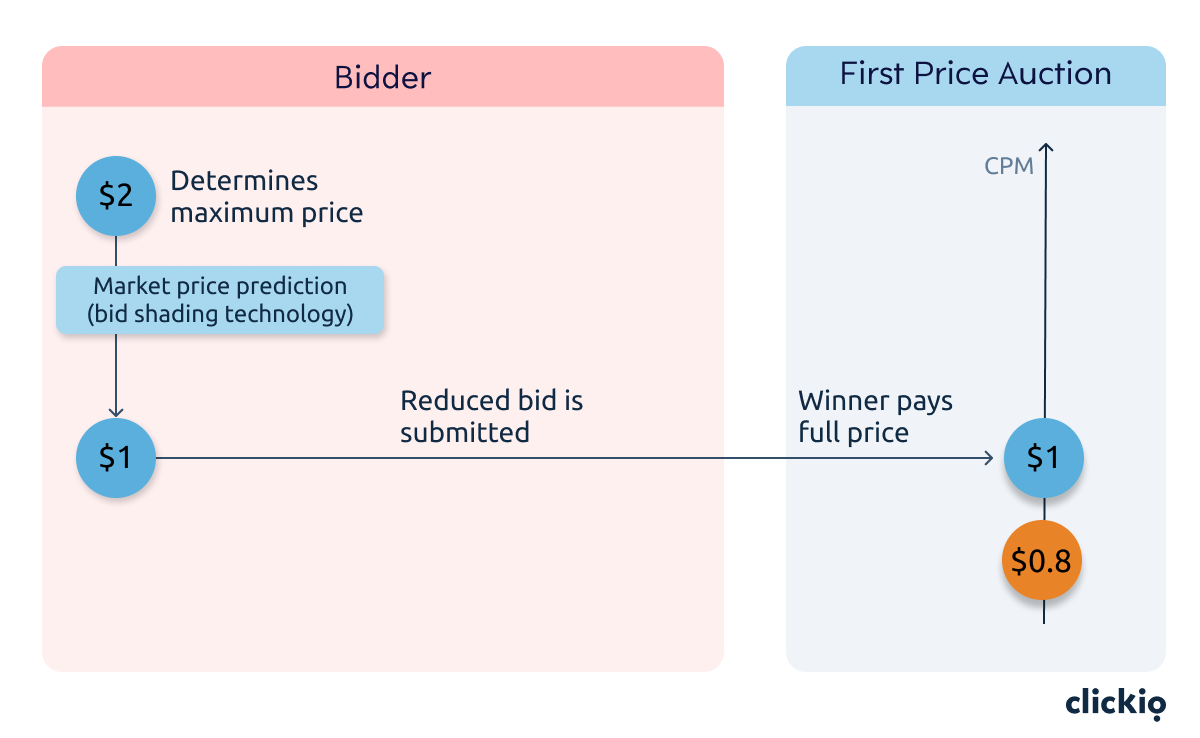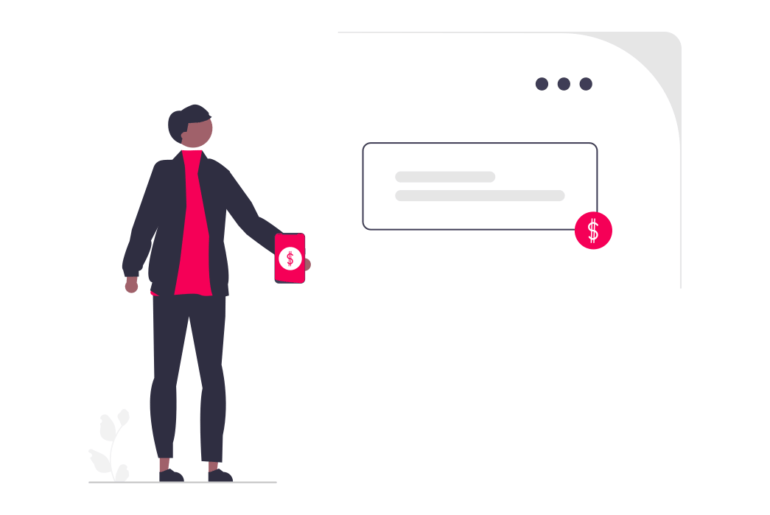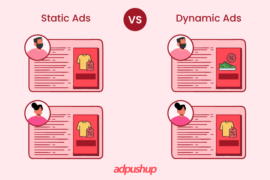Welcome to our comprehensive guide on bid shading, a critical concept in programmatic advertising. This article explores the ins and outs of bid shading, its benefits, and how you can use it to maximize your ad revenue.
With the new advancements making their way into the programmatic advertising realm, it has become quite challenging for advertisers to secure ad placements while maintaining a profitable ROI.
This is where bid shading comes in, enabling advertisers to optimize their bids and increase their chances of winning auctions while still saving money. It has worked wonders for the buyers (advertisers) by helping them save up to 20% on costs, according to recent data from The Trade Desk, Rubicon Project, and Pubmatic.
However, the Adweek report suggests that bid shading may be used to cover up for inefficient programmatic algorithms. In other words, advertisers may use bid shading to pay less for ad impressions that are not likely to perform well, rather than addressing the underlying issue of poor algorithm performance.
Having mixed thoughts about bid shading now? Don’t worry, stick to the blog, and you’re sure to get your answers.
In this article, we will get into the nitty-gritty of bid shading, how it benefits publishers and advertisers, and how you can implement it to maximize your ad revenue. So, whether you’re new to programmatic advertising or an experienced marketer, this guide will give you the insights you need to succeed in the advertising space.
Before we dive into what bid shading is, we first need to understand the reason why it emerged.
Also Read – Header Bidding Optimization – A Step-by-Step Guide
Moving from the second-price auction world
For a long time, second-price auction has been the industry standard in ad tech. Under second-price auctions, the buyer pays one cent more than the second-highest bid, while under first-price auctions, the buyer has to pay the exact bid they made.
So let’s say we have an auction with three bidders, who bid $10, $8, and $6 respectively for an impression. Under a first-price auction, the winning buyer will have to pay the full $10, in comparison, under a second-price auction, the winning buyer will pay $8.01. Second-price auctions protect the buyers from overpaying for impressions.

However, the problem with the second-price model is that it makes the auctions more complex and less transparent. Lately, major ad exchanges, including Google, have announced their intention of moving to a first-price model. Since most DSPs are optimized for reducing buyer costs in the second-price world, this shift to the first-price model presents a big problem for advertisers.
What is Bid Shading?
Bid shading is essentially a feature that enables DSPs and SSPs to reach a compromise when working under the first-price model. Recall the auction example from above, under first-price bidding, the buyer will have to pay $10 for the impressions. But buyers don’t want to pay for that.
So the SSP and DSP reach an agreement with regard to the final payout for the winning bid, which is usually placed somewhere between what the buyer might have paid in a second-price auction and a first-price auction. So instead of paying $8.01 (second-price) or $10 (first price), the buyer might pay $9—a compromise between both of those.
Bid shading was developed to retain buyers who aren’t happy having to pay significantly higher prices under the first-price model that has started gaining traction. “This is a product to soften the blow for buyers, especially DSPs, which aren’t yet configured to operate in a first-price world,” said Matt McIntyre, head of programmatic for EMEA, at Essence.
How Does Bid Shading Work?
How bid shading is implemented varies by ad tech vendors, the basic objective is to find and agree on a bid cost that lies somewhere between the first-price and second-price bid.
One way this is done is by taking the mathematical median between the first-price and second-price bid, this is a simple process, but not the most efficient in terms of estimating the best value for the bid. When using this method, in the above auction example, the final bid will be $9.
The other method is to look at previously recorded information such as bid-history, site stats, ad size, and win rates, and then determine the bid based on the estimated value of the impression.
According to figures released by The Trade Desk, Rubicon Project, and Pubmatic, bid shading can help buyers save about 20% in cost reductions with bid shading. Some vendors are offering bid shading as a free feature, while others are taking a cut from the money saved by using it.
Also Read – What is a Bid Request?
How are Publishers Impacted by Bid Shading?
Bid shading is primarily aimed at advertisers, it cushions them from the cost of paying the full amount as determined under the first-price auction model.
Ad tech is a zero-sum game, so if advertisers are saving 20%, obviously the publishers are feeling the loss. Before bid shading, buyers did not know how to bid properly under first-price auctions and temporarily overpaid, which benefited publishers. Now publishers are seeing their CPMs fall back down, and this may continue if bid shading algorithms continue to improve.
That said, given that the mid-range bid determined by bid shading algorithms will still be significantly higher than second-price bids, publishers should still get a good payout.
Now you must be wondering whether or not bid shading benefits the advertisers in any way.
Does Bid Shading Benefit the Publishers?
The answer is somewhat elusive, as this technique is generally more favorable for buyers than for publishers. Nevertheless, bid shading should enable publishers to achieve a good payout, despite the mid-range price being potentially higher than what they would have obtained in the second-price auction.
How Does Bid Shading Affect Publishers’ Revenue?
The impact of bid shading on publisher revenue is complex and not straightforward. On the one hand, the savings advertisers achieve with bid shading may come at the expense of publishers, leading to a zero-sum game. In contrast, the previous first-price auction approach often meant advertisers overpaid, allowing publishers to win.
Moreover, bid shading algorithms become more sophisticated, publishers are experiencing a decline in CPMs, and this trend is likely to continue. However, the effect on publishers is not entirely negative, as the mid-range bid calculated by bid shading algorithms should still be significantly higher than second-price bids. Therefore, publishers can still expect a reasonable payout in theory.
Moreover, publishers have access to several tools at their disposal. They can also employ an Ad Ops team to manage yield and maintain price control using the right ad technology.
Do Buyers Pay Extra?
Initially, buyers have not had to pay for bid shading. However, recent developments suggest that certain vendors may charge a fee to buyers who wish to utilize this method. This change may not be well-received by all buyers. Notably, Google and other independent vendors have their versions of bid shading, albeit packaged and branded differently.
Are There Any Downsides to Bid Shading?
While bid shading can be an effective strategy for advertisers, there are some downsides to consider.
Lower Impressions and Clicks
One potential downside is that bid shading can result in a lower volume of impressions or clicks. It is because bidding lower than the maximum bid may decrease the likelihood of winning the auction and showing ads to users.
Additionally, bid shading can lead to missed opportunities to reach users who may be more valuable to the advertiser but require a higher bid to win the auction.
Reduced Transparency of the Bidding Process
Next, bid shading may reduce the transparency and predictability of the bidding process. It’s because the actual bid amount may not be revealed to the advertiser, and the winning bid may be lower than expected. The lack of transparency can make it difficult for advertisers to accurately measure the effectiveness of their campaigns and optimize their bidding strategies.
Despite these potential downsides, bid shading remains popular among advertisers, particularly those looking to optimize their advertising spend. Advertisers should carefully consider the trade-offs between bid shading and other bidding strategies to ensure they achieve their advertising goals while minimizing any negative impact on campaign performance.
Who Provides Bid Shading Services?
Bid shading is available from several DSPs, SSPs, and ad exchanges, with all major players in the industry offering it.
Google Ad Manager, for instance, introduced first-price auctions across its network in 2019, enabling improved pricing transparency for display and video ads. Other primary bids shading players include MediaMath, Rubicon Project, PubMatic, and Google’s DV360.
Moreover, many buyers prefer utilizing a DSP’s bid shading tool over an exchange’s, as SSPs are incentivized to ensure you win through their exchange. In contrast, a DSP can provide a more comprehensive assessment opportunity.
What Future Holds for Bid Shading?
The future of bid shading is uncertain, but one thing that can happen is that it will continue to evolve as advertisers become more sophisticated in their targeting techniques. With the increasing availability of data and AI, bid shading will become more precise in targeting specific audiences.
Frequently Asked Questions on Bid Shading
Bid shading advertising is a technique advertisers use to bid lower than their maximum bid to win ad auctions.
A shadow bid is a secondary bid submitted by a buyer to compete with their initial bid in an auction.
In a blind bid, buyers submit their bids without knowing their competitors’ bids, and the highest bidder wins the auction.

Deepak has a keen eye for detail and a deep understanding of the ad tech landscape. Whether it’s through in-depth articles, thought-provoking insights, or compelling storytelling, he’s dedicated to helping people navigate the complex world of ad tech with the simplicity of his words.



![CTV vs OTT Advertising: Which one is Right Pick for Publishers? + [6 Bonus Strategies] Ott vs Ctv](png/featured-image-270x180.png)



